How To Print File Directory In Windows 7
Recently, I had to ship a friend a list of all the files and folders in a particular directory on my reckoner and it took me some time to figure out the best way to go nearly information technology. After playing around with various methods, I was able to create a overnice looking Excel spreadsheet with all the information on the files and folders plus additional info similar the size of files, last modified date, etc.
In this article I'g going to mention the two primary means to generate a directory listing: using the command line or using a third-party program. If your needs are very simple, the command line method is the easiest and doesn't require any additional tools. If you demand a more fancy written report, then bank check out the freeware utilities.
Command Line
So allow's get-go with the command line method first since it'south easy and volition probably be enough for xc% of the people reading this article. To get started, open Explorer and browse to the folder directory above the binder that you lot want to get the directory listing for.
If you lot want to print out the file and binder list for C:\Test\MyTestFolder, then navigate to C:\Test, press the SHIFT central and then right-click on the MyTestFolder. Go ahead and select Open command window here from the bill of fare.
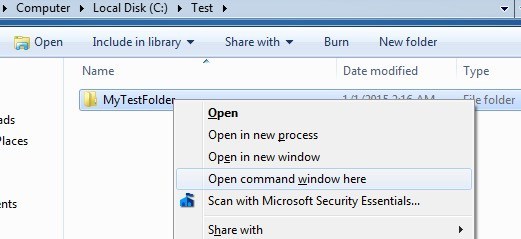
At the command prompt, you have to blazon a very unproblematic control:
dir >filename.txt
The dir control generates a list of files and folders in the electric current directory and the right angle subclass says that the output should be sent to a file rather than onto the screen. The file will be created in the current folder and if you open it using Notepad, it'll look like this:
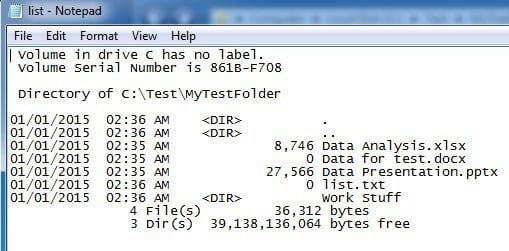
By default, the command will requite y'all the last modified appointment/fourth dimension, the size of the files, the listing of directories and the actual file names. If you want dissimilar information, y'all can add parameters to the command.
For example, if you don't want all that extra information, you can impress just the names of the files and folders using the post-obit command:
dir /b >filename.txt
In the above examples, you'll notice in that location is a folder chosen Give-and-take Stuff, but the output doesn't listing any of the files within that directory. If you desire to go a listing of all files and folders including subdirectories of the electric current directory, and so you lot would apply this command:
dir /b /s >filename.txt
Note that yous can too go rid of /b if yous want the total directory and subdirectory listing with the extra data on size, etc. Here is the output of dir /s >filename.txt below.
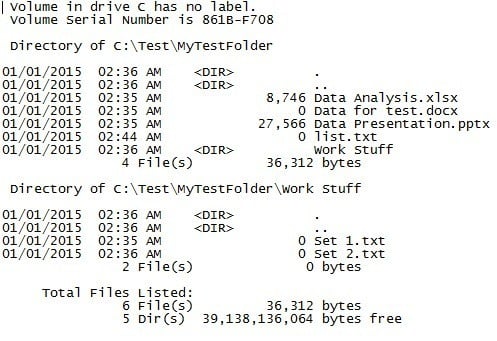
The dir control has a bunch of other control line parameters which I won't mention here, only you can check out a full list of them on Microsoft'due south website. Using the extra parameters, you tin can also prove file attributes (hidden, compressed, etc), show file ownership and more. You can and then import the data into Excel and cull tab-delimited so that the information will be separated into individual columns rather than beingness bunched into i.
Tertiary-Party Freeware
Directory List & Print
Ane of the best utilities for printing directory listings is Directory List & Impress. When you download it, you lot'll notice that some of the features are disabled. That'southward because the free version doesn't include all the options that are included in the Pro version. To unlock everything, you'll have to pay $20.
Even so, unless you really need to print out directory listings on a daily footing, the free version will be more than plenty for just well-nigh anybody. Once yous install it, you have to first cull the directory that y'all want to print out. Y'all can too choose from a list of favorites on the right hand side.
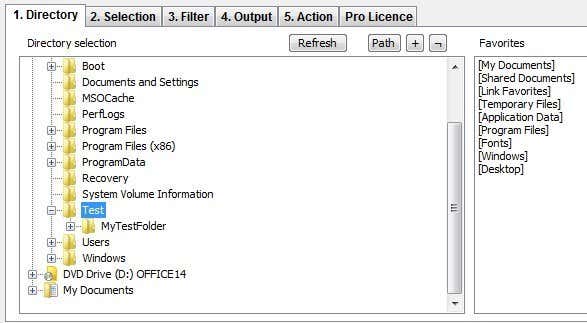
Annotation that at this bespeak, you should run into the output previewed in the bottom text window of the program. I really similar this considering you can play around with the unlike options and see the results updated instantly. Now click on the 2d tab named Selection.
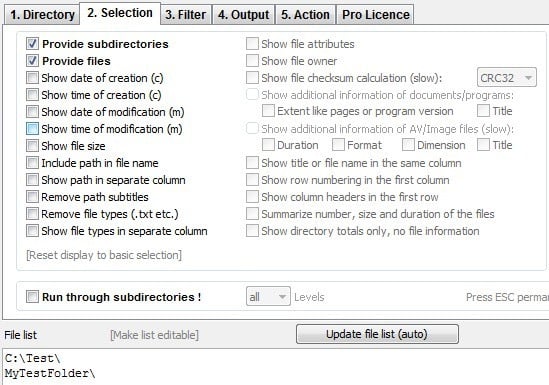
By default, Provide subdirectories and Provide files are checked. This means information technology'll impress out the listing of files in the current directory and will include any folders also in the current directory. Information technology will not list out the files that are in subdirectories. If you lot want to practice that, you have to check the Run through subdirectories box at the lesser.
As you lot tin see, yous tin include the cosmos date, modified appointment, file size, path, etc in the free version, merely if you want file owner, file attributes, etc, yous'll need to unlock the software. In the example below, I checked Show file size and Run through subdirectories to get this output:
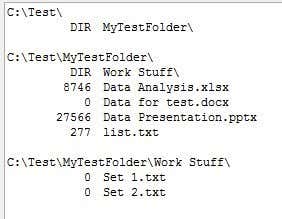
I'm going to skip the tertiary tab (Filter) because it's completely disabled in the free version. The paid version has some pretty avant-garde filtering options, but really just needed if you lot have thousands or millions of files. On the Output tab, you tin cull where y'all want to export the listing out to.
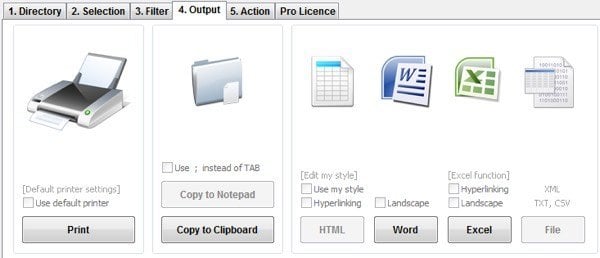
You can print it, copy to clipboard, or consign out to Word and Excel. To be annoying, they disabled copy to Notepad and export to file in the free version. The Action tab is besides completely disabled then won't become into it here. Overall, the gratuitous version of the program does a great job and more than enough to get a complete and thorough listing of a directory.
Karen's Directory Printer
Karen's Directory Printer is pretty old (2009), but nevertheless does a great job of exporting out directory listings. It doesn't take as many options as Directory List & Print Pro, but compared to the gratis version, it's quite close.
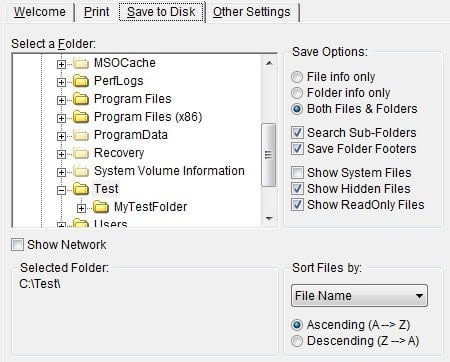
You lot have to pick from the Print tab or the Save to Disk tab first. Both are exactly the same, one just prints to a printer and the other saves the output to disk. Probably didn't need 2 carve up tabs for that, merely information technology'south an sometime program.
Selection your folder and choose whether you desire to print file names only, folder names only, or both. Yous can also tell it to search sub folders and print them out also. In addition, you can include or exclude system, hidden and read-simply files.
Clicking on the Testify Network checkbox will allow y'all to see all network drives and shares and impress out their structures too! This is great for function networks that accept folder shares on servers.
You can too sort by file name, file extension, file size, date created, date modified and more than. You can also put a file filter and then that merely certain types of files are printed, such every bit images just, sound files, executables, documents, etc.
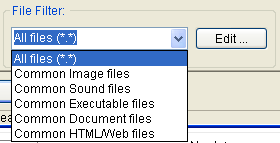
Finally, you can cull from a large number of attributes that yous want to include in your file impress list. Past default, it has a couple of items checked that I don't care about like attributes, appointment final accessed, etc. Just uncheck them and make sure to click on the Folder Info tab and do the same at that place.
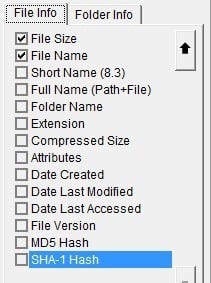
When saving the file to disk, the program inserts a bunch of useless comments, which can thankfully be removed by checking the Omit Comment Lines box. Y'all can as well go rid of the column that shows whether the row is a file or binder by checking the second box.

Finally, one other great feature of the program is that it adds an option to your Explorer context menu then that you can simply right-click on any binder and choose "Print with DirPrn".
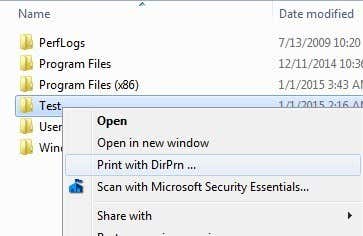
There actually isn't much else to the software than what I have shown in a higher place. It runs fine on Windows seven and Windows viii, so that's keen.
So those are all the dissimilar ways you can generate a directory listing for free with as much or as little information as needed. If you accept any questions, mail service a comment. Relish!
Practise non share my Personal Information.
Source: https://www.online-tech-tips.com/computer-tips/print-list-of-files-in-directory/
Posted by: hansenmirere.blogspot.com

0 Response to "How To Print File Directory In Windows 7"
Post a Comment